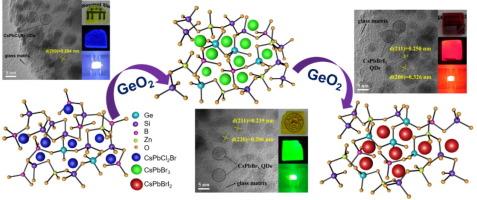调控局域玻璃网络提高CsPbX3 (X = Cl, Br, I)量子点经GeO2嵌入硼硅酸锌玻璃中的光学性能
IF 13.2
1区 工程技术
Q1 ENGINEERING, CHEMICAL
引用次数: 0
摘要
所有无机CsPbX3 (X = Cl, Br, I)钙钛矿量子点(QDs)具有优异的光学性能,在光电器件、信息存储、宽色域背光显示等领域显示出巨大的潜力。在以往的工作中,通过原位结晶将CsPbBr3量子点嵌入到玻璃基体中已成为提高量子点稳定性的重要策略。然而,采用熔淬法合成高质量全系CsPbX3量子点玻璃的报道很少。本文采用封闭熔淬技术合成了具有全可见光谱的CsPbX3量子点玻璃。并利用精确的GeO2含量来调节玻璃网隙的大小,以适应不同尺寸的CsPbX3量子点。反卷积红外光谱证实,GeO2的引入有利于刚性结构中非桥接氧的增加,[BO3]三角形单元的数量和百分比相应增加,玻璃网络呈三维、更松散的良性变化,有利于大尺寸量子点的生长。最后,分别改进了CsPbCl2Br、CsPbBr3和CsPbBrI2量子点玻璃的发光性能。优化后的CsPbX3量子点玻璃在全可见光谱(414-692 nm)具有可调谐的发光特性,提高了光致发光量子产率(PLQY, ~ 53.06 %),延长了衰减寿命,并且具有优异的稳定性。最后,白色发光二极管(WLED)器件的构建表明CsPbX3量子点玻璃在固态照明中具有潜在的应用前景。本文章由计算机程序翻译,如有差异,请以英文原文为准。

Regulating the local glass networks to enhance the optical performance of CsPbX3 (X = Cl, Br, I) quantum dots embedded in zinc borosilicate glasses via GeO2
All inorganic CsPbX3 (X = Cl, Br, I) perovskite quantum dots (QDs) have excellent optical properties, and show great potential in optoelectronic devices, information storage, wide color gamut backlight display and other fields. In previous work, embedding CsPbBr3 QDs into glass matrix through in-situ crystallization has become an important strategy to improve the stability of quantum dots. However, few reports have been made on the synthesis of high-quality whole family CsPbX3 QDs glass by melt-quenching method. Herein, CsPbX3 QDs glasses with full visible spectrum were synthesized by a closed melt-quenching technique. And the precise content of GeO2 was used to regulate the size of glass network gaps to accommodate different sizes of CsPbX3 QDs. The deconvoluted infrared spectra confirmed that the introduction of GeO2 was beneficial to the increase of non-bridging oxygen in the rigid structure, the number and percentage of [BO3] triangular units increased correspondingly, and the glass network changed in a three-dimensional and looser benign way, which was beneficial to the growth of large-size QDs. Finally, the luminescent properties of CsPbCl2Br, CsPbBr3 and CsPbBrI2 QDs glasses were improved respectively. The optimized CsPbX3 QDs glasses have tunable luminescence in the full visible spectrum (414–692 nm), improved photoluminescence quantum yield (PLQY, ∼53.06 %) and longer decay lifetime, and excellent stability. Finally, the construction of a white light-emitting diode (WLED) device shows that CsPbX3 QDs glass has potential applications in solid-state lighting.
求助全文
通过发布文献求助,成功后即可免费获取论文全文。
去求助
来源期刊

Chemical Engineering Journal
工程技术-工程:化工
CiteScore
21.70
自引率
9.30%
发文量
6781
审稿时长
2.4 months
期刊介绍:
The Chemical Engineering Journal is an international research journal that invites contributions of original and novel fundamental research. It aims to provide an international platform for presenting original fundamental research, interpretative reviews, and discussions on new developments in chemical engineering. The journal welcomes papers that describe novel theory and its practical application, as well as those that demonstrate the transfer of techniques from other disciplines. It also welcomes reports on carefully conducted experimental work that is soundly interpreted. The main focus of the journal is on original and rigorous research results that have broad significance. The Catalysis section within the Chemical Engineering Journal focuses specifically on Experimental and Theoretical studies in the fields of heterogeneous catalysis, molecular catalysis, and biocatalysis. These studies have industrial impact on various sectors such as chemicals, energy, materials, foods, healthcare, and environmental protection.
 求助内容:
求助内容: 应助结果提醒方式:
应助结果提醒方式:


